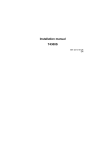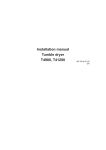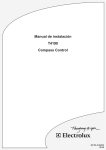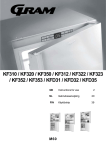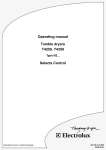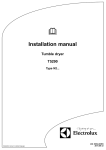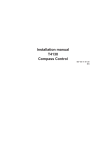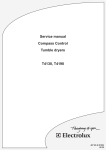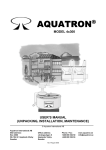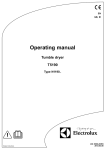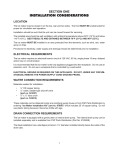Download Electrolux T4190 Installation manual
Transcript
Installation manual T4190 Compass Control 487 05 42 61.00 EN Safety instructions Safety instructions This machine is only intended for drying water-washed garments. Clothes that have been cleaned with chemicals/inflammable liquids, must NOT be dried in the machine. Remove clothes from the tumble dryer as soon as they are dry. This prevents them from becoming creased, and reduces the risk of spontaneous ignition. The machine must not be used for drying foam rubber or foamlike materials. The machine must not be used for drying floor mops*. The machine must not be used by minors. The machine must not be hosed down with water. Mechanical, electrical and gas installations must only be carried out by authorised personnel. If the machine has a fault, this must be reported as soon as possible to the person in charge. This is important for your own safety and for the safety of others. Gas dryers only: The machine is not to be installed in rooms containing cleaning machines with perchloroethylene, TRICHLOROETHYLENE or CHLOROFLUOROCONTAINING HYDROCARBONS as cleaning agents. What to do if you smell gas: Do not try to light any appliance. Do not touch any electrical switch; do not use any phone in your building. Evacuate the room, building or area. Contact the laundry manager. *Applies only to floor mops containing polypropylene. The dryer must not be installed behind a lockable door or sliding door. In the room where the dryer is to be installed the door hinges must be on the outer side. 3 4 Contents Contents Safety instructions ........................................................................................ 3 Technical data .............................................................................................. 6 Unpackning .................................................................................................. 8 Ship installation ............................................................................................ 9 Door reversal .............................................................................................. 10 Installation ...................................................................................................11 Function check ........................................................................................... 21 The manufacturer reserves the right to modify design and material specifications without notice. 5 Technical data 6 Technical data Heating Electric Gas Drum volume: 190 litres 190 litres Weight: Net 103 kg 103 kg Drum: Diameter Depth RPM G-factor 680 mm 555 mm 50 rpm 0.8 680 mm 555 mm 50 rpm 0.8 Capacity: Factor 1:25 Factor 1:33 7.5 kg 5.8 kg 7.5 kg 5.8 kg Heat effect: Electric 6.0 kW 8.0 kW 6.0 kW 8.0 kW Air consumption: Heat effect 6.0 kW 8.0 kW 270 m3/h 290 m3/h 270 m3/h 290 m3/h Piping: Evacuation Ø 125 Ø 125 Gas piping ISO 7/1 - R1/2 Pressure drop: Evacuation 6.0 kW 8.0 kW 380 Pa 350 Pa 380 Pa 350 Pa Sound power level: LW < 68 dB (A) < 68 dB (A) Technical data 7 Dimension sketch 1 Door opening 5 2 El. connection 3 Pipe connection, evacuation 4 Connection for external control mm A 720 B 745 mm L 575 M 80 C 1130 A D 420 Gas connection E 110 F 120 B G 960 H 45 I 55 K 1445 4 H 2 I 1 5 C G 3 L D E M K F Unpacking 8 Unpacking 1 Unpack the dryer from the packaging. Loosen the dryer from the pallet by cutting the plastic ribbons. Positioning Fig 1 Place the tumble dryer to ensure that work can be done as easily as possible by the user and the service technician alike. The door hanging can be changed. The distance to the wall or other equipment behind the dryer should be min. 300 mm and the distance to the sides min. 10 mm. However, there should be free access to the back of the dryer for the purpose of servicing it. Mechanical installation Fig 2 Adjust the dryer to ensure that it is horizontal and stands firmly on all four feet. The maximum height adjustment of the feet is 50 mm. When the adjustment has been made, lock the feet by means of the lock-nuts. Normally, the dryer requires no bolting to the floor or foundation. However, tumblers on a base do require anchoring. The fittings are fastened to the foundation using M10 expansion bolts or other devices of the same dimension. Special fittings are available from the supplier for this purpose. 2 Ship installation 9 Ship installation To ensure the steadiness of the dryer it is important to fasten it to the delivered base. Fig 1 Fasten the 4 fittings (supplied with the dryer) to the foundation using 4 x M10 set screws or other devices of the same dimension (not supplied). The 4 feet from the dryer are mounted on the base and the feet are fastened to the fittings. The dryer is fastened to the base using 4 x M10 bolts (supplied with the base) and is tightened with 20 Nm. Drilling template Min 400 1 675 M10 M10 Dryer 20 Nm 600 M10 Front M10 M10 Door 10 Door reversal 1 The door reversal illustrated below is on a lefthinged door. A Reversing the door • Disconnect the power to the dryer. On the dryer Fig 1 • Demount T-fitting A and screw the screws back into the same holes (in order to secure the plate on the back). • Disengage the door by carefully lifting it away from the front. (Make sure to get a good grip on the door - it is heavy). B 2 • Demount the front panel. Fig 1 Fig 2 Fig 3 • Demount T-fitting A and B and mount on the opposite side. • Loosen cable hanger with cable and mount on the opposite side. Strap the cable. • Move door switch to the opposite side. • Mount T-fitting A at the bottom of the right side. On the door Fig 4 • Move door handle to the opposite side, screw screws into holes. • Mount T-fitting B at the top of the right side. • Move ball lock in the door to the opposite side without turning the lock, move cover plate. On the dryer • Adjust the ball lock if required. Adjust the door height using the T-pieces. 3 Start the dryer • Reconnect the power to the dryer. • Check that the door switch is working: The drum must stop when the door is opened. 4 B Installation Evacuation system 11 1 Fresh-air For maximum efficiency and the shortest possible drying time, it is important to ensure that fresh air is able to enter the room from the outside in the same volume as that blown out of the room. Fig 1 5xA To avoid a draught in the room, it is advisable to place the air inlet behind the dryer. The area* of the air inlet opening must be 5 times the size of the vent pipe area. The resistance in the grating/ slats on the airinlet cover plate should not exceed 10 Pa (0.1 mbar). The air consumption is 400 m3/h. Fig 2 *The area of the inlet opening is the area through which the air can flow without resistance from grating/slatted cover. Note that gratings/slatted covers often block half of the total fresh air vent area. Remember to take this into account. 2 5xA Installation 12 Exhaust duct 3 It is recommended that each dryer be connected separately to a smooth air outlet pipe with the lowest possible friction. Fig 3 If more than one dryer is connected to the same outlet pipe, the pipe diameter must be increased after each dryer, just as all dryers must be equipped with a back draft damper to prevent humid air from running back into dryers that are not in operation. The pipe must end outside in the open. The outlet must be protected against rain, foreign objects and prevailing winds. 4 Note! In cold areas, condensation may cause frost damage to the building. Gentle bends Fig 4 To keep the air flowing, ensure proper dryer operation, and minimise lint buildup in the exhaust system, never connect ducts at right angles, always use gentle bends. Service organisation/dealer If you have questions relating to the design of the exhaust system, please contact your local dealer or service organisation. No. of dryers Outlet m3/h d mm Fresh-air intake cm2 Pipe length 0-70 m d 1 290 Ø125 400 Ø125 2 440 Ø125 800 Ø160 3 660 Ø125 1200 Ø200 4 880 Ø125 1600 Ø250 Installation Gas installation To be carried out by qualified personnel Mount a manual shutt-off valve prior to the dryer. The gas pipe to the dryer must be dimensioned to an output of 6.6 kW / 8 kW. From factory the nozzle pressure setting corresponds to the heating value printed on the data label on the back of the dryer. Check that the nozzle pressure and heating value are according to the values given in the table. If not, contact the supplier. Bleed the pipe system before connecting the dryer. After connection, test all joints for leaks. 13 Installation 14 Gas valve 1 5 To adjust the pressure unscrew the 6 screws on the cover plate at the back of the dryer. 1. Nozzle 2. Measuring branch, nozzle pressure 3. Nipple 4. Adjusting screw 5. Control Box, gas valve 6. Measuring branch, supply pressure 6 2 3+4 Test run 1. Loosen the measuring branch screw (2) anticlockwise a 1/4 of a turn. 2. Connect a manometer to measuring branch (2). 3. Select a programme that uses heat. 2 4. Start the dryer. 5. Check the nozzle presure, see tables on the following pages. 6. If necessary adjust adjusting screw (4) found behind nipple (3). 7. After testing, prepare the dryer for use. 1 Installation Converting to another type of gas 15 1 If the dryer is to be converted to another type of gas, the gas nozzle and the air reducing plate must be replaced, see tables on the following pages. LPG If the dryer is to be converted to LPG, use the air reducing plate and the matching nozzle. To change the reducing plate follow step 3-7 in the chapter "Changing the nozzle". Subsequently mount the plate in the 2 holes and then follow step 8-9, see fig. 1. Town gas 6 kW If the dryer is to be converted to town gas 6 kW, use the air reducing plate and the matching nozzle. To change the reducing plate follow step 3-7 in the chapter "Changing the nozzle". Subsequently mount the plate in the 4 holes and then follow step 8-9, see fig. 2. 2 Town gas 8 kW If the dryer is to be converted to town gas 8 kW, use the air reducing plate and the matching nozzle. To change the reducing plate follow step 3-7 in the chapter "Changing the nozzle". Subsequently mount the plate in the 4 holes and then follow step 8-9, see fig. 3. Note! The burner bracket must be mounted, see fig. 1. Natural gas 3 If the dryer is to be converted to natural gas, remove all air reducing plates. Note! The burner bracket must be mounted, see fig. 1. Installation 16 Changing the nozzle 1 1. Shut off the manual gas valve. 2. Disconnect the electrical power supply. 3. Unscrew the back plate. 4. Dismount the electrode wire on the left side of the heating box, fig 1. 5. Dismount the compression nut and the compression ring. Pull the coupling from the nozzle, fig 2. 6. Unscrew the 8 screws of the heating box. 7. Lift the cover upwards and pull it to the right - still sitting on the edge. 8. Dismount the nozzle and replace it with the right dimension, see tables on the following pages. 9. Assemble in the opposite order as described above. 2 Installation 17 Gas installation Tables of pressure and adjustments T4190 heat effect: 6 kW Gas type Connection Pressure Nozzle Pressure Nozzle Air reducing plates Denmark Norway Sweden Finland LPG GNH 30 20 30 8.2 3 2.35 A Italy England Spain Portugal Ireland Greece LPG GNH 28/37 20 28/37 8.2 1.3 2.35 A France Belgium LPG GNH GNL 28/37 20/25 20/25 28/37 20/25 20/25 1.3 1.95 1.95 A Germany LPG GNH GNL 50 20 20 30 8.2 12.1 1.3 2.35 2.35 A Holland LPG GNL 30 25 30 12.1 1.3 2.35 A Austria LPG GNH 50 20 30 8.2 1.3 2.35 A Japan LPG 28 28 1.3 A Denmark Sweden Italy Town gas Group a 8 4.5 3.95 B Town gas Group b 8 3.5 3.95 B Note! Because of the differences in gasinstallation regulations in European Union it is important to use the Italian-language manual in Italy and the French-language manual in France ect. Installation 18 Gas installation Tables of pressure and adjustments T4190 heat effect: 8 kW Gas type Connection Pressure Nozzle Pressure Nozzle Air reducing plates Denmark Norway Sweden Finland LPG GNH 30 20 30 9 1.45 2.65 A Italy England Spain Portugal Ireland Greece LPG GNH 28/37 20 28/37 9 1.45 2.65 A France Belgium LPG GNH GNL 28/37 20/25 20/25 28/37 20/25 20/25 1.45 2.2 2.2 A Germany LPG GNH GNL 50 20 20 30 9 13.4 1.45 2.65 2.65 A Holland LPG GNL 30 25 28.8 13.4 1.25 2.65 A Austria LPG GNH 50 20 30 9 1.25 2.65 A Japan LPG 28 28 1.45 A Denmark Sweden Italy Town gas Group a 8 4.5 4.45 C Town gas Group b 8 3.5 4.45 C Note! Because of the differences in gasinstallation regulations in European Union it is important to use the Italian-language manual in Italy and the French-language manual in France ect. Installation 19 Electric installation Electrical installation must be carried out by an authorized personnel! It is important to know that the machines are designed to provide a high level of personal safety, which is why items of external equipment such as earth leakage circuit breakers are not necessary. If you still want to connect your machine across an earth leakage circuity breaker, please remember the following: • For maximum reliability, connect only one machine per earth leakage circuit breaker. • It is important that the earth wire is properly connected, including to earth leakage circuit breaker. • Mount a multi-pole switch prior to the machine to facilitate installation and service operation. • The connecting cable should hang in a gentle curve. • Check that the earth has been connected in correct way. Fuse ratings are given in the tables below. For the rating of the supply cable, check the local regulations. Cable dimensioning table, electric heating Heating type Voltage type Total rating kW Fuse A El. 6.0 kW 400-415V 3N AC 6.3 10 El. 6.0 kW 230-240V 1 AC 6.3 35 El. 6.0 kW 400-440V 3 AC 6.3 10 El. 6.0 kW 200-240V 3 AC 6.3 20 El. 8.0 kW 400-415V 3N AC 8.3 16 El. 8.0 kW 400-440V 3 AC 8.3 16 El. 8.0 kW 230-240V 3 AC 8.3 25 Total rating kW Fuse A Cable dimensioning table, gas heating Heating type Voltage type Gas 400-415V 3N AC 0.25 10 Gas 400-480V 3 AC 0.25 10 Gas 200-240V 3 AC 0.25 10 Gas 230-240V 1 AC 0.25 10 Installation 20 Single-phase connection Fig 6 6 Connect Earth wire to GND terminal, Live to terminal L1 and Neutral to terminal N as shown in the example in the figure. GND N When the installation is completed, check: L3 • That the drum is empty. L2 L1 • Turn on the main switch and choose a drying program. Start the machine. Three phase connection Fig 7 Connect Earth wire to GND terminal, Live to terminal L1, L2, L3 and Neutral to terminal N (3N AC only) as shown in example "3 AC" and "3N AC" in the figure. X1 X2 External connection Max. 1.25A 1 AC 6309 7 3 AC When the installation is completed, check: GND • That the drum is empty. N • Turn on the main switch and choose a drying program. Start the machine. L3 L2 L1 External connection (3NAC) Fig 8 A special connection terminal is located at the mains connection. X1 X2 External connection Max. 1.25A 6308 The connection terminal is used for: Connection/control of external fan or a condeser. 3N AC Max. connected load is 1.25A. GND Marine version (3AC) N External connection L3 L2 A special connection terminal is located on the tumbler motor bracket. The terminal for external control is equipped with 110V/max. 100mA and is intended solely for the operation of a contactor (external control of a fan). Max. connected load is 100mA. L1 X1 X2 External connection Max. 1.25A 6307 8 6330 Function check Function check 21 1 Check that the drum is empty and the door has been closed. Start the dryer Check that the door switch is working. The drum must stop if the front door is opened. Check the direction of rotation Fig 1 This is done by selecting the “No heat” programme. • Start the dryer. Leave the dryer running for 30 seconds. • Open the door quickly. Observe the direction of rotation of the drum is clockwise. Isolate the machines electrical supply - swap the positions of the incoming supply phases at the main terminal block - re-establish the supply and re-test. Final test • Let the dryer work for 5 minutes on a program that requires heat. • Check that the heating is working by opening the front door and feel the heat. If the above test-points are in order, the dryer is ready for use. Service organisation / dealer If deficiencies or a fault are detected, please contact your local service organisation / dealer. 6311 www.electrolux.com/professional Share more of our thinking at www.electrolux.com about | case studies | contact 0845 077 65 65 Home Laundry Equipment Ozone Laundry Systems Chemicals Services Special Offers Ex Rental Testimonials Contact Us

























